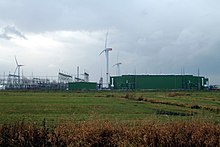
A high-voltage direct current (HVDC) electric power transmission system uses direct current (DC) for electric power transmission, in contrast with the more common alternating current (AC) transmission systems.

The Moyle Interconnector is a 500 megawatt (MW) HVDC link between Scotland and Northern Ireland, running between Auchencrosh in Ayrshire and Ballycronan More in County Antrim. It went into service in 2001 and is owned and operated by Mutual Energy.
TenneT is a transmission system operator in the Netherlands and in a large part of Germany.

HVDC BorWin1 is the first HVDC facility in the world to be built for importing power from an offshore wind park to shore, and the first to use voltage source converters (VSC) in Germany. It connects the offshore wind park BARD Offshore 1 and other offshore wind farms in Germany near Borkum to the European power grid. The facility was built by ABB and has a capacity of 400 MW at a bipolar voltage of ±150 kV. HVDC BorWin1, which leads from BorWin Alpha Offshore Platform to Diele substation, consists of a 75 kilometres (47 mi) of underground and 125 kilometres (78 mi) of submarine cable.
BritNed is a 1,000 MW high-voltage direct-current (HVDC) submarine power cable between the Isle of Grain in Kent, the United Kingdom; and Maasvlakte in Rotterdam, the Netherlands.

Nordsee-Ost offshore wind farm is an offshore wind farm in operation in the eastern part of the North Sea German sector. The project was developed by RWE Innogy, a subsidiary of RWE.
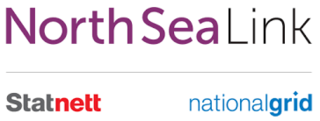
The North Sea Link is a 1,400 MW high-voltage direct current submarine power cable between Norway and the United Kingdom.
HVDC DolWin1 is a high voltage direct current link built to transmit offshore wind power to the power grid of the German mainland. The project differs from most HVDC systems in that one of the two converter stations is built on a platform in the sea. Voltage-Sourced Converters are used and the total cable length is 165 km. The project was built by ABB and was handed over to its owner, TenneT, in July 2015, the fifth such project to be completed in Germany in 2015.
The Western HVDC Link is a high-voltage direct current (HVDC) undersea electrical link in the United Kingdom, between Hunterston in Western Scotland and Flintshire Bridge in North Wales, routed to the west of the Isle of Man. It has a transmission capacity of 2,250 MW and became fully operational in 2019.

HVDC BorWin2 is a high voltage direct current (HVDC) link built to transmit offshore wind power to the power grid of the German mainland. The project differs from most HVDC systems in that one of the two converter stations is built on a platform in the sea. Voltage-Sourced Converters are used and the total cable length is 200 km. The project was completed by the Siemens/ Prysmian consortium and handed over to its owner, TenneT, in January 2015, becoming the first such project to be completed.
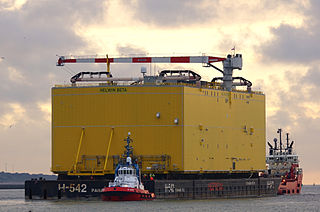
HVDC HelWin2 is a high voltage direct current (HVDC) link built to transmit offshore wind power to the power grid of the German mainland. The project differs from most HVDC systems in that one of the two converter stations is built on a platform in the sea. Voltage-Sourced Converters with DC ratings of 690 MW, ±320 kV are used and the total cable length is 130 km. The project was built by the Siemens/Prysmian consortium with the offshore platform built by Heerema in Zwijndrecht, Netherlands. The topside measures 98 m x 42 m x 28 m and weighs 10200 tonnes. The project was handed over to its owner, TenneT, in June 2015, the fourth such project to be completed in 2015.
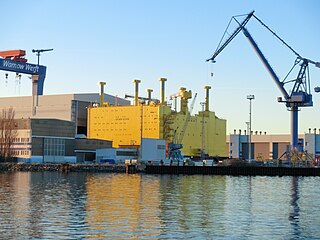
HVDC SylWin1 is a high voltage direct current (HVDC) link to transmit offshore wind power to the power grid of the German mainland. The project differs from most HVDC systems in that one of the two converter stations is built on a platform in the sea. Voltage-Sourced Converters with DC ratings of 864 MW, ±320 kV are used and the total cable length is 205 km. The project is similar to the HVDC BorWin2 project but has slightly higher power and voltage ratings. It is being built by the Siemens/ Prysmian consortium and was handed over to its owner, TenneT, in April 2015.
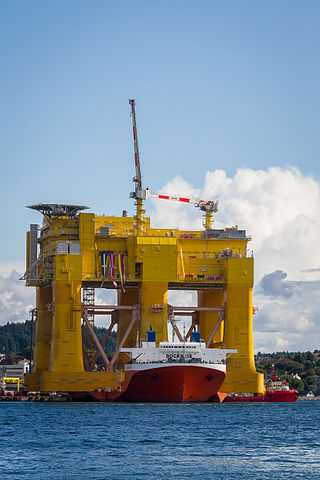
HVDC DolWin2 is a high voltage direct current (HVDC) link to transmit offshore wind power to the power grid of the German mainland. The project differs from most HVDC systems in that one of the two converter stations is built on a platform in the sea. Voltage-Sourced Converters with DC ratings of 900 MW, ±320 kV are used and the total cable length is 135 km. The project is similar to the HVDC DolWin1 project but has a slightly higher power rating and uses a different design of offshore platform. The platform was designed by Norwegian company Aibel and built by Drydocks World in Dubai and transported to Europe in the summer of 2014 to be fitted out at the Aibel yard in Haugesund in Norway. The platform, which is of a floating, self-installing design not previously used in an HVDC project, sailed out from Haugesund on 1 August 2015 and was installed in the North Sea ten days later.
HVDC DolWin3 is a high voltage direct current (HVDC) link to transmit Offshore wind power to the power grid of the German mainland. The project differs from most HVDC systems in that one of the two converter stations is built on a platform in the sea. Voltage-Sourced Converters with DC ratings of 900 MW, ±320 kV are used and the total cable length is 160 km.
HVDC BorWin3 is a high voltage direct current (HVDC) link under construction to transmit offshore wind power to the power grid of the German mainland. The project differs from most HVDC systems in that one of the two converter stations is built on a platform in the sea. Voltage-Sourced Converters with DC ratings of 900 MW, ±320 kV are used and the total cable length is 160 km. The project is the most recent of the German offshore HVDC projects to be awarded. It is being built by the Siemens/ Petrofac consortium with the offshore platform contract awarded to Drydocks World in Dubai. The project is expected to be handed over to its owner, TenneT, in 2019. The project started power transmission in August 2019. TenneT took control of operations in February 2020.
COBRAcable is a ±320 kV, 700 MW HVDC submarine power cable pair between Eemshaven, the Netherlands and Endrup near Esbjerg, Denmark. The cable is jointly owned by Energinet.dk and TenneT. Its purpose is to improve the European transmission grid and thus increase the amount of variable wind power in the system while improving supply reliability. Its 700 MW capacity corresponds to an annual transmission capacity of 6.1 TWh.
Nemo Link is an HVDC submarine power cable between Richborough Energy Park in Kent, the United Kingdom and Zeebrugge, Belgium. The project is a joint venture between British National Grid and Belgian Elia. The electrical interconnector is the first between the two countries, capable of transmitting up to 1,000 MW at 400 kV for an annual transmission capacity of 8.76 TWh. The link has been fully operational since 31 January 2019.
Kriegers Flak is a 605 MW offshore wind farm in the Baltic Sea on the Danish part of the reef of the same name. It forms part of a new 400 MW interconnector between Denmark and Germany.

Veja Mate is a German 402 MW offshore wind farm in the German Bight of the North Sea about 95 km northwest of Borkum. The wind farm consists of 67 Siemens Wind Power SWT-6.0-154 turbines, each with a 6 MW capacity.
